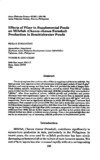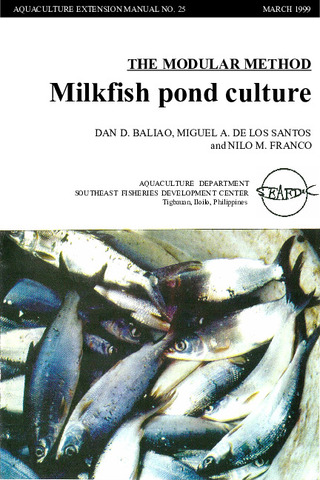Effects of fiber in supplemental feeds on milkfish (Chanos chanos Forsskal) production in brackishwater ponds
- Global styles
- MLA
- Vancouver
- Elsevier - Harvard
- APA
- Help
Share
Abstract
The study explores the nutritive value of fiber in supplemental feeds for milkfish. The feeding rates were adjusted so that all treatments involved equal protein-N load (6 g·kg-1 fish/day), and varying energy and fiber loads. Rice hull provided the bulk of dietary fiber. Fresh chicken manure, containing 16% protein, served as control. Four 800-m2 earthen ponds divided into four compartments were used. Milkfish juveniles (29 g) were stocked at 7,000·ha-1. After three months of culture, milkfish growth and production and protein efficiency ratio were significantly higher (α = 0.05) in fed ponds than in manured ponds. Average yield and manure conversion ratio in manured ponds were 436 kg·ha-1 and 14.5, respectively. There was no significant difference in yields (600-624 kg·ha-1) between feed treatments. Fish exposed to low protein/33% fiber diet had a worse feed conversion ratio (5.8) than those exposed to high protein/15 or 24% fiber diets (3.6). The results indicate that energy was not limiting in the high fiber (24%) treatment compared to low fiber (15%), but additional fiber (33%) did not further improve growth; and fiber in low protein diets was utilized further as a direct or indirect source of energy. Thus, a low protein/high fiber diet can be an economical way of increasing milkfish production in brackishwater ponds.
Suggested Citation
Sumagaysay, N. S., & Chiu-Chern, Y. N. (1991). Effects of fiber in supplemental feeds on milkfish (Chanos chanos Forsskal) production in brackishwater ponds. Asian Fisheries Science , 4(2), 189-199. http://hdl.handle.net/10862/1358
Type
ArticleISSN
0116-6514Collections
- Journal Articles [1258]
Related items
Showing items related by title, author, creator and subject.
-
Series: Aquaculture extension manual; No. 25
The modular method: Milkfish pond culture
Baliao, Dan D.; de los Santos, Miguel A.; Franco, Nilo M. (Aquaculture Department, Southeast Asian Fisheries Development Center, 1999)The modular method of milkfish culture (Chanos chanos) described in the manual is an improvement over the traditional extensive method. The manual is intended for the use of fish farmers and aquaculturists, extensionists, ... -
Evaluation of organic and inorganic fertilizers in brackishwater milkfish ponds
Bombeo-Tuburan, Isidra; Agbayani, Renato F.; Subosa, Precilla F. (Elsevier, 1989)The study was conducted in twelve 144-m2 ponds to evaluate the effect of different organic and inorganic fertilizers on the growth, survival, gross production, and profitability of marketable milkfish. The ... -
Milkfish breeding and hatchery technology at SEAFDEC/AQD
Unknown author (Aquaculture Department, Southeast Asian Fisheries Development Center, 1999)Describes the techniques already adopted by the private sector: broodstock management, broodstock diet, commercial fry production, live transport, and larval diet. A list of AQD research publications on milkfish is included.






